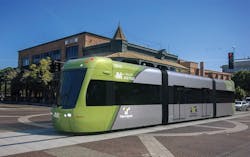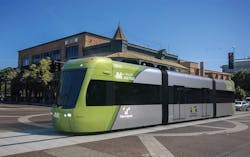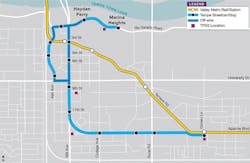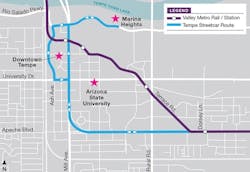College town in Arizona keeps community close with streetcar system
Many years ago, Tempe was a quaint suburban community east of central Phoenix. Things changed over the years as Arizona State University (ASU) grew to what it has become today. A year-round academic institution, ASU boasts some of the largest student enrollment of all public universities across the country. Its home campus is at the heart of Tempe, with a population of some 60,000 students and more than 4,000 academic staff. ASU is a key reason Tempe has grown in its unique way and evolved into a vibrant and progressive community.
In keeping up with student growth and demand, Tempe has welcomed many businesses in its downtown and throughout the city to build a comfortable yet vibrant community. Today, there are several big industries with offices in the heart of Tempe including Microsoft, State Farm, JP Morgan Chase, and U.S. Airways, to name a few. In all, the central Tempe area is made up of long-lived residential neighborhoods, the university and its students, attractive and friendly parks, unique downtown commercial businesses, essential and effective community services, and a growing modern business district consisting of sleek high-rise office buildings and condominiums.
The city is constantly challenged in providing efficient streets, available parking, and transit service to this diverse population. And while they have been very successful, the continued growth and change in the age of the urban community has created a need for alternative modes of transportation; that is, a high-capacity transit service to augment the valley’s popular light-rail system. A high-capacity transit system to extend deeper into Tempe’s downtown area would significantly improve local and regional mobility, especially during peak travel times. It would also enhance access to regional employment centers such as the university and the thriving business district. But just as importantly, it would become the backbone for current and planned economic and transit-oriented development adjacent to the corridor. That is why the 2004 voter-approved Regional Transportation Plan’s concept was to build 57 miles of high-capacity transit improvements in the region, with part of that being a streetcar line to serve the central Tempe area.
ROADMAP FOR SUCCESS
According to regional forecast models and data, Tempe is expected to be on the leading edge of growth in the area with more than 3% growth annually over the next 15 years. This means an additional 65,000 people and 19,000 housing units will become a part of the existing community. The forecast also shows employment in Tempe is expected to grow by 44,000, with 52% of that growth occurring within a half-mile of the planned streetcar corridor.
During the planning process, any transit solution had to be developed and evaluated with specific consideration to the following major objectives:
- Meet the purpose and need for the Tempe South Corridor (the planning corridor)
- Address the travel markets in the study area
- Minimize environmental impacts
- Respond to agency and community input
Through this evaluation processes, streetcars were selected as the most effective and beneficial option for the community. Thus in 2013, the city council voted in support of moving forward with the streetcar solution.
The Tempe Streetcar project is widely seen as beneficial to economic development and downtown redevelopment. The major benefits of the proposed streetcar include:
- Increasing transit ridership in the corridor and mitigating the pressure for parking and street congestion
- Connecting students and residents to neighborhood services in the downtown area
- Encouraging redevelopment (and rezoning) of underutilized parcels along the corridor
- Encouraging reinvestment in neighborhoods
- Promoting livable city and green initiatives
- Supporting ASU travel demand
- Improving service for special events at ASU and in the downtown area
- Providing a seamless connection to light-rail transit (LRT)
The connection to LRT is of particular relevance to the development of the metropolitan area. In 2008, Valley Metro began revenue service on a 20-mile light-rail corridor linking Phoenix, Tempe, and Mesa. Over the past 10 years, it has extended its service line at both ends by another 8 miles. Today, there are several projects in the planning and design phase that will continue to expand the LRT system. Six high-capacity transit extensions are under construction that will create a 50-mile system by 2030.
The streetcar, being part of the Regional Transportation Plan, is viewed as a unique extension of Valley Metro’s transit system. Conveniently, it allows for riders to take light rail from Phoenix and Mesa, or anywhere along its corridor, into Tempe. With two connections offered between light rail and the streetcar, riders can travel into the heart of downtown Tempe, along the length of its modern business district, and around ASU’s campus from the student housing neighborhood to Sun Devil Stadium.
A MIXED-TRAFFIC ROUTE
To address the need for increased mobility while keeping cost within budget, the streetcar corridor needs to be as efficient as possible. Consequently, the route is defined by connecting ridership with major destinations in the area. As a result, the corridor is identified as the alignment shown in the map above.
Tempe Streetcar consists of a 3-mile track running from south to north with an additional half-mile running north to south creating a loop in the downtown area. Along the 3.5-street-mile route there is approximately 1.25 miles of track that will be in exclusive right-of-way. There are a total of 14 stops throughout the corridor, two of which are situated adjacent to light-rail stations. Four streetcar vehicles will be used to provide service on the route. Two additional vehicles will be available as extra fleet for special events or for replacement when maintenance is required.
Part of defining the corridor was to embrace one of the most fundamental features of streetcars—their ability to travel in vehicle lanes. The key advantage to sharing the traffic lane with streetcars is to minimize exclusive trackway corridors. Doing so avoids expensive right-of-way acquisition and roadway widening costs. However, it does introduce a new challenge—to maintain effective speed of the streetcars while driving in shared, and potentially congested, traffic lanes.
In laying out the Tempe Streetcar alignment, Stantec recognized several cost-effective opportunities to allow for exclusive streetcar lanes within the existing roadway corridor, avoiding the potential for delays to the streetcar schedule. This was generally accomplished by eliminating some on-street parking areas, narrowing some existing roadway medians, and optimizing the street width to its capacity. In two locations, however, a one-track exclusive guideway was defined, which best suited the cost and operations of the streetcar line. This means that streetcars need to be coordinated and timed to allow for one vehicle to enter and exit a particular section, known as an interlocking, before another vehicle may enter the same section of track. If streetcars maintain the planned headways of approximately 15 minutes, the vehicles will not have to wait for the track section to clear. Doing so allows the streetcars to operate safely in exclusive right-of-way and be out of the way of vehicle traffic.
The city of Tempe also recognized the potential for traffic congestion along the streetcar route, especially during peak hours and special events in the area, a guarantee on ASU football game days. To streamline operations and mitigate delays, the city is installing a GPS-based traffic management system on its streetcar vehicles and along the corridor. A wireless system by MTrack will monitor the locations of streetcars and provides priority to the streetcar vehicles as they approach signalized intersections.
INTRODUCING HYBRID TECHNOLOGY
The streetcar line runs north on Mill Avenue from University Drive to Rio Salado Parkway. But on the return in the southbound direction, the vehicles will go a block farther west on Rio Salado Parkway and use Ash Avenue and University Drive to return to Mill Avenue. This alignment in the downtown area has given the city two main concerns. First, Mill Avenue in the downtown has historically been landscaped with trees. Today the tree canopies reach well into the streetcar clearance envelope of the overhead contact wire system. Trimming the trees back to accommodate the overhead contact wire would be devastating to their health and drastically affect the appearance and pedestrian experience of the downtown. Second, all four intersections that roughly define the downtown area will have streetcar-turning movements, which would require significantly more poles and structural elements to support an overhead contact wire on a curve for the vehicle as it makes its turn.
The solution? Provide a hybrid-type streetcar vehicle that runs on an overhead contact system or on battery (in the downtown area) without overhead wires. The hybrid vehicle certainly responds to the city’s two concerns about preserving the downtown trees and keeping the major intersections clean in appearance; however, it does create a challenge for operations of the streetcars. The hybrid vehicle is a relatively new technology in the U.S. and is rapidly gaining popularity. It has been observed in other cities where streetcars operate, that raising and lowering the pantograph (the mechanical armature above the vehicle that has contact with the overhead contact wire to power the vehicle) is a manual process initiated by the operator.
The Stantec design team worked with Valley Metro to develop an automated pantograph operation system to engage and disengage the pantograph depending upon the location of the vehicle. The system incorporates a train-to-wayside control (TWC) that uses a two-way communication function. As an example, when a vehicle enters the northbound off-wire section on Mill Avenue, it sends a signal to the TWC antenna in the concrete slab, which relays the signal to the processor unit in the control cabinet. The processor confirms the vehicle identification and provides the direction to lower the pantograph. Then the vehicle lowers the pantograph and confirms the directive. As a fail-safe, there is also signage that the operators will see to remind them of what is taking place.
WORKING TOWARD A TRANSIT-ORIENTED NEIGHBORHOOD
In addition to the placement and design of the streetcar system, the project is spurring enhanced urban development along and near the corridor.
During the design process, there were 13 significant property developments in various stages (planning, design, and construction) along the streetcar corridor. All of the projects are deemed to be transit-oriented developments, ranging from retail space, residential units, and hotels to commercial and office space. The design team recognized the importance of close coordination and sharing of design documents to ensure a win–win for everyone involved in this enhancement of the downtown area. Coordination and communication are essential for developers and designers alike to ensure necessary clearances for utilities to the development sites, to establish agreements on who does what in the construction of street and sidewalk improvements, and even how one of the streetcar platforms gets built in front of a high-rise project. This level of coordination with the developers was done throughout the streetcar corridor design phase and is, as of this writing, ongoing in a Construction Manager at Risk (CMAR) scenario with Stacy and Witbeck, now that the project is in the construction phase.
While construction in a downtown environment can cause significant difficulties for businesses, the partners of Valley Metro, Tempe, and Stacy-Witbeck had a business and marketing assistance plan in place long before construction began. Because of this, they have not only minimized disturbances along the work zone but have created exciting programs to entice the public to safely move through the construction area and continue to enjoy the businesses along the corridor.
While streetcars are hardly a new mobility solution, Tempe Streetcar is an efficient, cost-effective approach that will meet the needs of the community. Thoughtful planning, sustainable technology, and transit-oriented development make it a transit solution for the 21st century.




